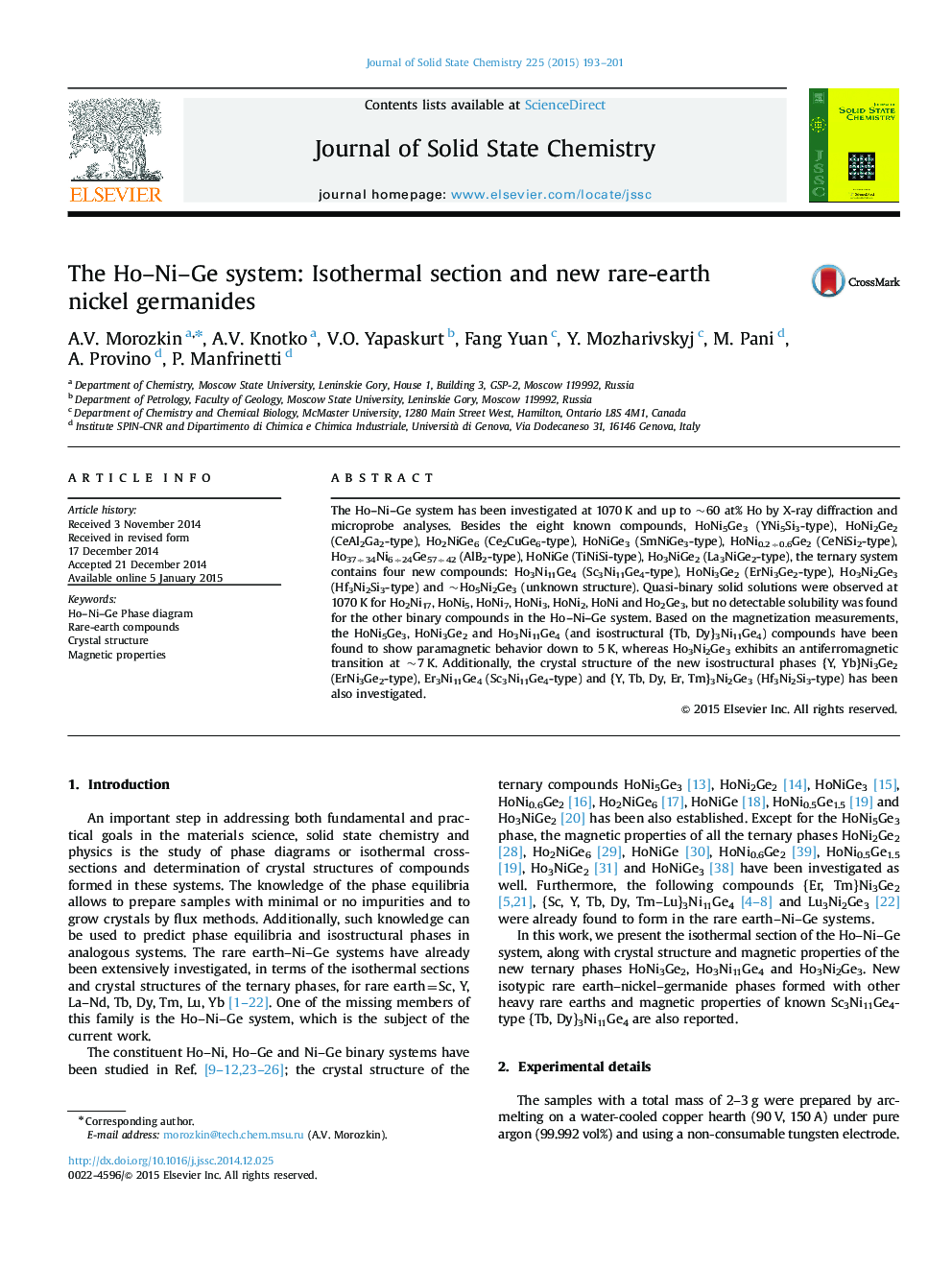| کد مقاله | کد نشریه | سال انتشار | مقاله انگلیسی | نسخه تمام متن |
|---|---|---|---|---|
| 1331619 | 1500091 | 2015 | 9 صفحه PDF | دانلود رایگان |

• Ho–Ni–Ge system has been investigated at 1070 K and up to ~60 at% Ho.
• Eight known ternary holmium nickel germanides were confirmed in Ho–Ni–Ge.
• Four new holmium nickel germanides were detected in Ho–Ni–Ge.
• Eight new rare earth nickel germanides were detected in {Y, Tb, Dy, Er–Yb}–Ni–Ge.
• HoNi5Ge3, HoNi3Ge2,{Tb, Dy, Ho}3Ni11Ge4 and Ho3Ni2Ge3 are paramagnet down to 5–7 K.
The Ho–Ni–Ge system has been investigated at 1070 K and up to ~60 at% Ho by X-ray diffraction and microprobe analyses. Besides the eight known compounds, HoNi5Ge3 (YNi5Si3-type), HoNi2Ge2 (CeAl2Ga2-type), Ho2NiGe6 (Ce2CuGe6-type), HoNiGe3 (SmNiGe3-type), HoNi0.2÷0.6Ge2 (CeNiSi2-type), Ho37÷34Ni6÷24Ge57÷42 (AlB2-type), HoNiGe (TiNiSi-type), Ho3NiGe2 (La3NiGe2-type), the ternary system contains four new compounds: Ho3Ni11Ge4 (Sc3Ni11Ge4-type), HoNi3Ge2 (ErNi3Ge2-type), Ho3Ni2Ge3 (Hf3Ni2Si3-type) and ~Ho5Ni2Ge3 (unknown structure). Quasi-binary solid solutions were observed at 1070 K for Ho2Ni17, HoNi5, HoNi7, HoNi3, HoNi2, HoNi and Ho2Ge3, but no detectable solubility was found for the other binary compounds in the Ho–Ni–Ge system. Based on the magnetization measurements, the HoNi5Ge3, HoNi3Ge2 and Ho3Ni11Ge4 (and isostructural {Tb, Dy}3Ni11Ge4) compounds have been found to show paramagnetic behavior down to 5 K, whereas Ho3Ni2Ge3 exhibits an antiferromagnetic transition at ~7 K. Additionally, the crystal structure of the new isostructural phases {Y, Yb}Ni3Ge2 (ErNi3Ge2-type), Er3Ni11Ge4 (Sc3Ni11Ge4-type) and {Y, Tb, Dy, Er, Tm}3Ni2Ge3 (Hf3Ni2Si3-type) has been also investigated.
The Ho–Ni–Ge system has been investigated at 1070 K and up to ~60 at.% Ho by X-ray and microprobe analyses. Besides the eight known compounds, i.e. HoNi5Ge3 (YNi5Si3-type), HoNi2Ge2 (CeAl2Ga2-type), Ho2NiGe6 (Ce2CuGe6-type), HoNiGe3 (SmNiGe3-type), HoNi0.2÷0.6Ge2 (CeNiSi2-type), Ho37÷34Ni6÷24Ge57÷42 (AlB2-type), HoNiGe (TiNiSi-type), Ho3NiGe2 (La3NiGe2-type), the ternary system contains four new compounds: Ho3Ni11Ge4 (Sc3Ni11Ge4-type), HoNi3Ge2 (ErNi3Ge2-type), Ho3Ni2Ge3 (Hf3Ni2Si3-type) and ~Ho5Ni2Ge3 (unknown structure). Quasi-binary solid solutions were found to form at 1070 K from the binary Ho2Ni17, HoNi5, HoNi7, HoNi3, HoNi2, HoNi and Ho2Ge3 compounds, while no detectable solubility was observed for the other binary compounds in the Ho–Ni–Ge system. Based on the magnetization measurements, the HoNi5Ge3, HoNi3Ge2 and Ho3Ni11Ge4 (and isostructural {Tb, Dy}3Ni11Ge4) compounds have been found to show paramagnetic behavior down to 5 K, whereas Ho3Ni2Ge3 exhibits an antiferromagnetic transition at ~7 K. Additionally, the crystal structure of the new isostructural phases {Y, Yb}Ni3Ge2 (ErNi3Ge2-type), Er3Ni11Ge4 (Sc3Ni11Ge4-type) and {Y, Tb, Dy, Er, Tm}3Ni2Ge3 (Hf3Ni2Si3-type) has been also investigated.Figure optionsDownload as PowerPoint slide
Journal: Journal of Solid State Chemistry - Volume 225, May 2015, Pages 193–201